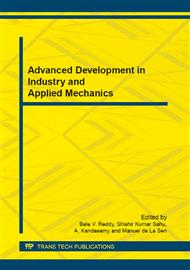[1]
A.M. Krivtsov, O.S. Loboda, Description of elastic properties of diamond and sphalerite-structured diatomic crystals with the use of moment interaction, Physical Mesomechanics. 15 (3-4) 2012 238-244.
DOI: 10.1134/s1029959912020129
Google Scholar
[2]
A.M. Krivtsov, O.S. Loboda, S.S. Khakalo, Comparison of micromodels describing the elastic properties of diamond, Mechanics of Solids. 47 (5) 2012 525-532.
DOI: 10.3103/s0025654412050056
Google Scholar
[3]
O.S. Loboda, A.M. Krivtsov, Determination of mechanical properties of nanostructures with complex crystal lattice using moment interaction at microscale, Reviews on Advanced Materials Science. 20 (2) 2009 143-147.
Google Scholar
[4]
M. Wiercigroch, A.M. Krivtsov, J. Wojewoda, Vibrational energy transfer via modulated impacts for percussive drilling, Journal of Theoretical and Applied Mechanics. 46 (3) 2008 715-726.
Google Scholar
[5]
D.A. Indeitsev, A.M. Krivtsov, P.V. Tkachev, Molecular dynamics analysis of the relation between the spall strength and strain rate for solids, Doklady Physics. 51 (3) 2006 154-156.
DOI: 10.1134/s1028335806030141
Google Scholar
[6]
F.A. Gilabert, A.M. Krivtsov, A. Castellanos, Molecular Dynamics modeling of the adhesive interaction between fine particles, Powders and Grains. Proceedings of the 5th International Conference on Micromechanics of Granular Media. 1 2005 513-516.
Google Scholar
[7]
E.M. Galimov, A.M. Krivtsov, A.V. Zabrodin, T.M. Eneev, Yu.I. Sidorov, Dynamic model for the formation of the Earth-Moon system, Geochemistry International. 43 (11) 2005 1045-1055.V.N. Bukhartsev, M.R. Petrichenko, Condition of mechanical-energy balance of an integral flow with a variable rate, Power Technology and Engineering. 35 (4) 2001 189-194.
Google Scholar
[8]
A. Sprince, G. Fischer, L. Pakrastinsh, A Korjakins, Crack propagation in concrete with silica particles, Advanced Materials Research. 842 2014 470-476.
DOI: 10.4028/www.scientific.net/amr.842.470
Google Scholar
[9]
A. Sprince, A. Korjakins, L. Pakrastinsh, Time-dependent behavior of high performance fiber-reinforced concrete, Advanced Materials Research. 705 2013 75-80.
DOI: 10.4028/www.scientific.net/amr.705.75
Google Scholar
[10]
A.N. Badanin, A.K. Bugrov, A.V. Krotov, Justification of the first critical load of the granular environment of the sandy basis, Magazine of Civil Engineering. 9 2012 29-35.
DOI: 10.5862/mce.35.4
Google Scholar
[11]
A.D. Girgidov, Change of dissipation of energy upon transition from the laminar mode to the turbulent, Magazine of Civil Engineering. 5 2011 49-52.
Google Scholar
[12]
M.R. Petrichenko, Nonsteady filtration in a uniform soil mass, Power Technology and Engineering. 46 (3) 2012 198-200.
DOI: 10.1007/s10749-012-0331-z
Google Scholar
[13]
V.N. Bukhartsev, M.R. Petrichenko, Nonsteady filtration in a uniform soil mass, Power Technology and Engineering. 46 (3) 2012 1-3.
DOI: 10.1007/s10749-012-0331-z
Google Scholar
[14]
V.N. Bukhartsev, M.R. Petrichenko, Problem of filtration in a uniform rectangular soil mass is solved by variational principles, Power Technology and Engineering. 46 (3) 2012 185-189.
DOI: 10.1007/s10749-012-0329-6
Google Scholar
[15]
V.N. Bukhartsev, M.R. Petrichenko, Problem of filtration in a uniform rectangular soil mass is solved by variational principles, Power Technology and Engineering. 46 (3) 2012 1-5.
DOI: 10.1007/s10749-012-0329-6
Google Scholar
[16]
V.N. Bukhartsev, M.R. Petrichenko, Condition of mechanical-energy balance of an integral flow with a variable rate, Power Technology and Engineering. 35 (4) 2001 189-194.
Google Scholar
[17]
V.N. Bukhartsev, M.R. Petrichenko, Condition of mechanical-energy balance of an integral flow with a variable rate, Hydrotechnical Construction. 35 (4) 2001 189-194.
DOI: 10.1023/a:1011669518499
Google Scholar
[18]
V.N. Bukhartsev, M.R. Petrichenko, Conditions of mechanical-energy balance of an integral flow with a variable rate, Hydrotechnical Construction. 35 (4) 2001 189-194.
DOI: 10.1023/a:1011669518499
Google Scholar
[19]
M.R. Petrichenko, Convective heat and mass transfer in combustion chambers of piston engines. Basic results, Heat transfer. Soviet research. 23 (5) 1991 703-715.
Google Scholar
[20]
M.R. Petrichenko, A.B. Kanishchev, L.A. Zakharov, B. Kandakzhi, Some principles of combustion of homogeneous fuel-air mixtures in the cylinder of an internal combustion engine, Journal of Engineering Physics. 59(6) 1990 1539-1544.
DOI: 10.1007/bf00870411
Google Scholar
[21]
M.R. Petrichenko, A.D. Mezheritskii, Options in the quasi-stationary method of designing impulse turbines for supercharging internal combustion engine systems, Soviet energy technology. 5. 1989 13-17.
Google Scholar
[22]
M.R. Petrichenko, A. Yu. Shabanov, Hydrodynamics of oil film under internal combustion engine piston rings, Trudy LPI. 411 1985 38-42.
Google Scholar
[23]
N.I. Vatin, Weight vector of a conduction transducer of a correlation flowmeter, Magnetohydrodynamics New York, N.Y. 21 (3) 1985 316-320.
Google Scholar
[24]
Yu.A. Buryan, V.N. Sorokin, Way of identification of oil recovery of layer and the device for its implementation, patent for the invention RUS 2379488 08. 08. (2007).
Google Scholar
[25]
V.P. Bocheninskii, N.I. Vatin, V.S. Shmarov, Results of research of transients in liquidly metal contours. (1981).
Google Scholar
[26]
N.I. Vatin, T.N. Mikhailova, Computation of cross correlation function of induced potential for developed turbulent flow with axisymmetric mean velocity profile, Magnetohydrodynamics New York, N.Y. (1986).
Google Scholar


